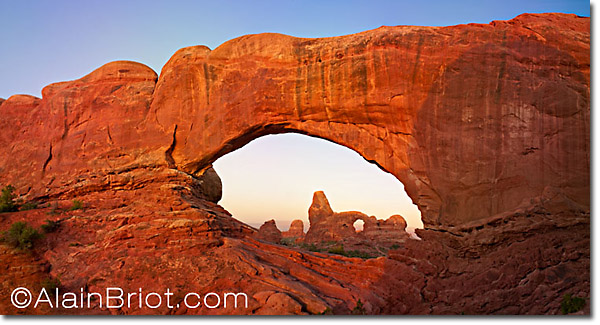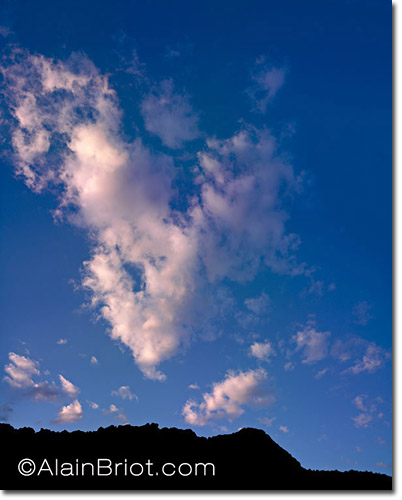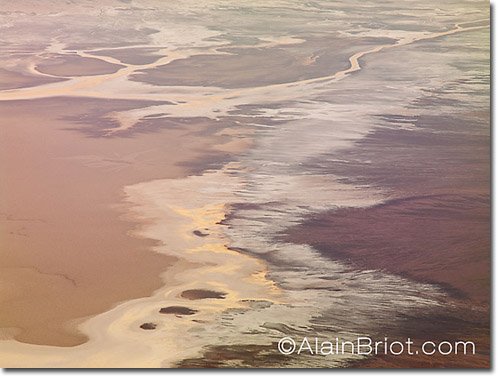Preparation In Fine Art Landscape Photography: Part Two |
1 - Introduction
In part two of this 2-parts essay we are going to look at the gear you take with you in the field and at what you do once you are in the field. This second part is presented as a checklist so that you can print it to refer to it in the field if you want. I kept the text to a minimum to make this checklist as concise as possible.

2 - Your Gear
A - Necessary gear
- Primary camera and backup camera
- Lenses: wide, normal, telephoto: 12 to 300 for full-frame 35mm
- Several extra batteries for all battery-operated gear
- Cleaning cloth and dust blower
- Sensor cleaning kit
- Cable release
- Camera manual if you are not 100% familiar with all camera functions
- Tripod and ballhead
- Padded camera bag
- Hoodman loupe
- Cleaning cloth
- Basic tools such as small screwdrivers, pliers, hex wrenches, etc.
- Camera L-Bracket
B - Things to keep in mind when using gear in the field
- Extend your tripod to full height
- You must be able to look through your viewfinder without bending over
- Doing so is more comfortable and will prevent back pain
- Turn lens hood forward so it shades the lens
- Don’t keep the lens hood pointing backwards on the lens
- Tighten all ballhead and tripod clamps securely
- Turn on blinking highlights on camera histogram
- Know how to read your histogram quickly and accurately
- Expose to the right
- When not shooting, keep your camera ready to use in your bag
- Keep the lens you use most often on your camera
- If using a technical camera, keep the camera assembled for faster access
- Know how to set mirror lockup on your camera
- Use a cable release when the camera is on tripod
C - Carry cameras and lenses in a padded camera bag at all times
Cameras and lenses are fragile and expensive. If not stored in your camera bag they will eventually be damaged, broken or lost. When you are working in the field, lenses and cameras should not be placed on the road, on the ground, on rocks, walls, etc. They should not be carried in your shirt or pants pockets either. They should be carried only in your padded camera bag.
D - Do not walk with your camera on your tripod
If you sling your tripod over your shoulder with your camera attached to it, you take the chance of launching your camera as if it was a missile. Therefore, never sling your tripod over your shoulder with your camera on it and do not walk or hike with your camera on your tripod. When moving from one location to another remove your camera from the tripod and pack it in your camera bag. Sooner or later you will be thankful you did.
E - Use a tripod bag
Quality tripods and ballheads are as expensive as camera equipment. To protect them I carry my carbon fiber tripod and RRS ballhead in a Tamrac tripod bag. This bag is inexpensive (about $30) and I recommend you use one. You can buy this bag, or a similar one, from Amazon.com, B&H or other.
F - Never leave your camera on your tripod unattended
Leaving your camera on your tripod unattended is recipe for disaster. If your tripod falls you won’t be there to stop it and your camera will break. Therefore, if you need to move away from your camera and tripod for any reason, take your camera off your tripod, pack it away in your camera bag and pack your tripod in your tripod case.
G - Purchase insurance
Even when taking all the precautions mentioned above, working in the field with expensive camera gear carries a certain amount of risk. I therefore recommend that you purchase insurance for damage and theft to protect yourself in case something unexpected happens.

3 - Your Approach
A - What you have to decide personally:
- Where do you want details?
- Highlights, shadows, both?
- This will determine how you need to expose the scene
- Not every photograph needs to be HDR!
- It is OK to not have details in every area of a photograph
- Exposure in fine art photography is in part an artistic decision
- Which lenses do you like the most?
- What color palette do you want to use?
- Do you like color, black and white, infrared, alternative processes, duotones, etc.?
B - Walking the scene
As you walk in the landscape looking for pleasing compositions ask yourself:
- What do I want to photograph? - What type of composition am I looking for? - Is the light good? - Is there a photograph here? - What is catching my eye? - What is unique, different, or significant about the composition in front of me? - How can I make this composition stronger, or different from the photographs of the same scene I have seen before?
Do not take a photograph if you are not sure what is significant in your composition. Instead, continue looking for a composition you really like, a composition that “talks” to you.
C - Create both Verticals and horizontals
When you find a composition you really like, create vertical and horizontal versions of this composition, provided the image lends itself to both formats. That way you are OK should you wish to use the photograph vertically or horizontally later on. For example, verticals are necessary for book covers while horizontals are necessary for 2-page spreads.
D - Use all three Lens families
Take a photograph of the same scene (obviously not of the same composition) with at least one lens from the 3 lens families: wide angle, normal and telephoto.
Take these three (or more) photographs one after the other so the light does not change between photographs.
E - Use a cardboard (or optical) viewfinder
Using a viewfinder is different than looking at the scene through your camera. First it is lighter, smaller and you can carry it in your shirt pocket. Second, it is not technical and therefore you can focus on seeing the composition instead of also thinking about f-stop, shutter speed, ISO and other technical issues. Finally, a viewfinder lets you look at the composition through different “lenses” very quickly by moving it closer or further from your eye, and both vertically and horizontally, by turning it up and down.
F - Be considerate of other photographers
We all want to bring back the best photographs possible, but unless we all work together none of us will. The key to getting along with everyone is to be considerate. Watch where other photographers are, make sure you do not get in their shots, and ask they do the same for you. Cooperating with each other will make the shoot a success. This has become particularly important now that there are more and more photographers at popular locations.

4 - Conclusion: Practice, Practice, Practice!
The tips I share with you here and in Part 1 need to be practiced in order to become second nature. The goal is to make preparation and technical aspects automatic so that you can focus on the artistic and creative aspects of fine art photography. Creativity requires comfort and peace of mind. You cannot be creative when you are uncomfortable or when your equipment is failing you! Only when everything is working smoothly can you can let go of physical realities and focus on what you see in your mind’s eye.
Comments on NPN landscape photography articles? Send them to the editor. NPN members may also log in and leave their comments below.
 Alain Briot creates fine art photographs, teaches workshops and offers DVD tutorials on composition, raw conversion, optimization, printing, marketing photographs and more. Alain is also the author of Mastering Landscape Photography and Mastering Photographic Composition, Creativity and Personal Style. Both books are available from Amazon and other bookstores as well from Alain’s website.
Alain Briot creates fine art photographs, teaches workshops and offers DVD tutorials on composition, raw conversion, optimization, printing, marketing photographs and more. Alain is also the author of Mastering Landscape Photography and Mastering Photographic Composition, Creativity and Personal Style. Both books are available from Amazon and other bookstores as well from Alain’s website.
You can find more information about Alain's work, writings and tutorials as well as subscribe to Alain’s Free Monthly Newsletter on his website at http://www.beautiful-landscape.com. You will receive over 40 essays in PDF format, including chapters from Alain’s books, when you subscribe.